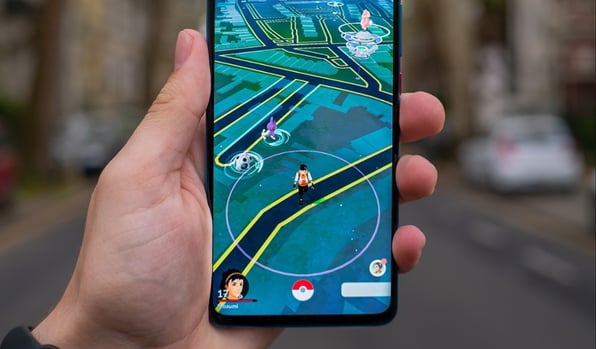The Element That Turned PokemonGo into a National Obsession (and What Every Brand Can Learn From It)
Take a peek outside your window right now, and chances are you’ll see a small herd of wandering teenagers and Millennials, staring at their phones and occasionally stumbling over each other.
They’re playing PokemonGo, an augmented reality mobile game launched to instant mass obsession in recent weeks.
Let’s face it, we all thought Pokemon was something that disappeared years ago, like the Furby or Pogs (bonus points if you remember those).
In reality, Pokemon has been doing just fine with a cult following. But Nintendo thrust it back into the mainstream by infusing new technology, a bit of gamification, and most importantly, the chance for individuals to discover a like-minded community.
Most brands aren’t Pokemon, or Nintendo. But some of the key mechanisms behind PokemonGo can be applied to just about any business.
The biggest one?
Give the people who interact with your brand the most an outlet to connect and engage each other, and you may just see some amazing results.
WHO SHOULD BUILD A COMMUNITY?
Every business has customers or members, and within those are fans. There is always a benefit to bringing fans together, whether you’re an international gaming giant or running a neighborhood lawn service.
For most businesses, a Facebook page will suffice. There’s just not much discussion to be had around mowing lawns, but you still want a forum for fans.
You should definitely have an online community...
- If your business is built around serving specific lifestyles (think Red Bull, Brooks Running)
- Your product or service frequently iterates or evolves (think Android, Apple, Raspberry Pi)
- If your business provides a service to a group with common needs (think Oracle, Salesforce.com, professional associations)
- If your product or service is customizable to the consumer or can be used as a tool (think scrapbooking, Toyota, Wordpress)
This can be expanded, but if your business falls into one or more of these categories, you probably have a tribe that wants to talk about you and with you. In fact, they’re already doing so, on sites like Twitter, Yelp, and Reddit.
THE DRAWBACKS OF CREATING A COMMUNITY
Generally, there are two common objections to creating a community.
The first is need. Most businesses don’t recognize the need to connect their customers. There are customer service reps to deal with the things people want to talk about, after all.
And this is true of many businesses, but it lessens each day.
Think of user conferences. Every business seems to have one, where they bring together customers for a couple days of learning and interacting.
Remember, people choose their loyalty based on emotions as much as anything. Emotions come from connections to people and experiences with others.
Your community is out there, even if it isn't massive just yet.
Just because you’re not going to have a thousand posts each day on the community forum doesn’t mean it isn’t valuable.
And sometimes people want to learn how to solve problems from peers, not your call center.
The second common objection is the potential for upset customers to dominate the conversation.
The adage is that one rotten apple can spoil the whole lot. So, one angry customer can wade into the community, share his anger, and quickly recruit others to his cause.
It’s a legitimate concern. Consumers wield big sticks now, and a happy mob can turn angry in an instant for the most innocuous of reasons.
Another concern related to this is the need to police the community.
Building a community requires someone to watch over it. A good community manager is tough to find, because they have to represent the brand while also blending into the crowd. The person who can maintain the balance all the time is rare.
If these are too much for you, then by all means, don’t build a community. But these aren’t big deals, right?
WHY YOU SHOULD BUILD A COMMUNITY
The benefits of a community can totally offset these common objections.
First, regarding the angry customers, you want to hear their objections and issues. And you want to have it on your turf, around people who know your brand.
The rules of online customer complaint management still apply: no deleting comments, speedy responses, and try to take the conversation offline. But you’d rather execute this on your forum than in front of the universe on Twitter or Facebook.
Think for a moment about the inverse of an angry mob. The joyful mob, valiant defenders of your righteous and noble brand. Would such a merry group be possible without a gathering place?
Helping with this is the emergence of the Superuser. This is the person who represents your brand better than anyone, who is so in tune with your product and/or brand that they’ve invested themselves in your success.
FRPD and several neighborhood folks hunting Pokemon pic.twitter.com/CUL4orkNpg
— Fall River Police (@FallRiverPD) July 10, 2016
Superusers, despite being unpaid, will lead the community. They’ll help people answer questions, and defend the brand against unfair criticism.
Without a forum, without a voice, you may never truly get to know your superusers.
You can float out ideas, offer product beta testing opportunities, connect directly with customers (think of hosting regular Ask Me Anything sessions on your own site!), and so much more than you could ever do with one-way communication.
The biggest benefit of a branded community is better customer engagement. Any time you can bring people into positive contact with your brand on something other than a sales message, you win.
Even if all they’re doing is posting corny jokes on an off-topic thread, that’s a win for the brand. It means they’re comfortable within the community, and you enabled that.
GO FOR ENGAGEMENT
Access isn’t a community forum company, so we don’t have anything to sell you here. Loyalty is the goal, and engagement is the path. Building a community, whether it’s through a fun mobile game or an online forum, can give you a big leap in engagement.
This is your opportunity to go out and build something, a gathering place where your customers can become members. They may not be roaming the streets of America tripping over themselves while they stare at phones, but they’ll have a good reason to reach out to your brand every day.
(PokemonGo image courtesy of)
Topics: Customer Engagement
Written by: Brandon Carter






.jpeg)







Share your Comment.